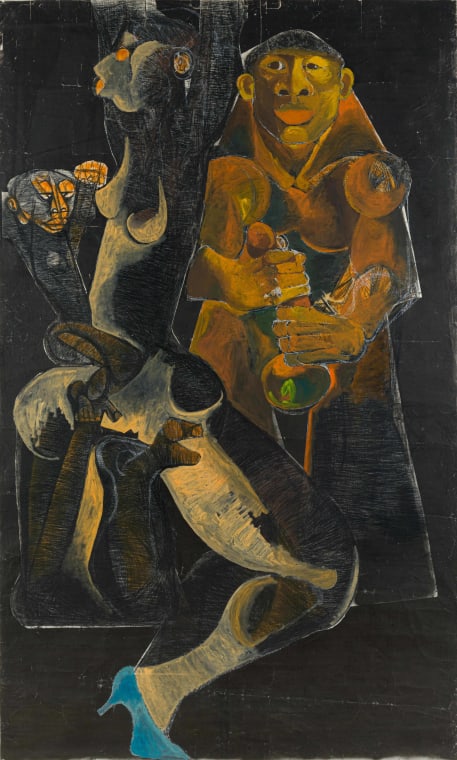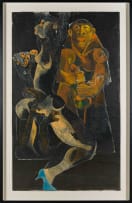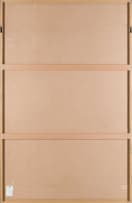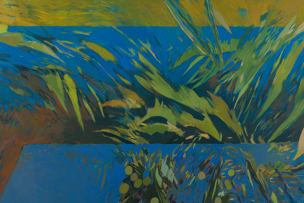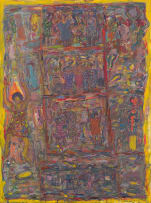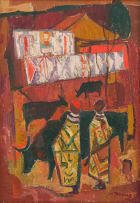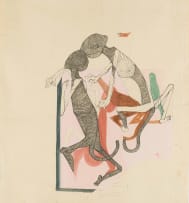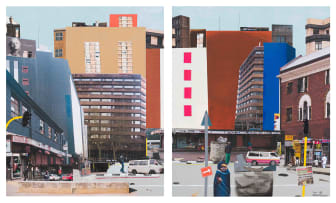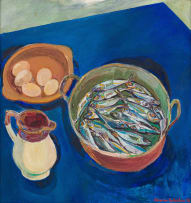Modern and Contemporary Art
Live Virtual Auction, 16 May 2023
Modern and Contemporary Art
Incl. Buyer's Premium & VAT
About this Item
Notes
Dumile Feni is best known for his monochrome drawings of human figures. Art historians and critics have fairly lauded his 'powerful line and violently contorted imagery', 'radical deconstruction and reassembly of form' and 'vocabulary of distortions of the human anatomy'.1 The mechanics of Feni's schematic compositions are compelling, as is evident in this important lot, but so is his use of colour. Feni was a capable colourist who not infrequently used watercolour, conté crayon and pastel, the medium of this large work. Colour is a formal attribute of an artwork, to make it the sole subject of deliberation, particularly in relation to Feni, necessarily devalues the existential heft of his traumatised iconography. Ivor Powell writes of Feni's iconography that it was very much of its time, combining aspects of German expressionism, African reductionism and ecclesiastical medievalism. 'Where Feni is incandescently different is that he never merely repeats an inherited formula,' writes Powell. 'There is always an edge, a wilfulness and a confrontational quality to the work that takes it into another dimension. Where most of his township contemporaries … would take allegorical refuge in Christian symbolism, maybe hinting at political realities behind that symbolism, Feni's versions of the Madonna and Child refer instead, and pointedly, to West African sculpture in their conception, and as often as not render up either the mother or the child as markedly simian'.2
Feni's 2005 retrospective at the Johannesburg Art Gallery included a suite of these large satirical drawings, including the present lot. These works, says Anitra Nettleton, reveal Dumile's awareness of carnivalesque imagery and propensity to ridicule shop-worn clichés from western art like the Madonna and Child motif.3 This lot is unique in its wholesale use of colour. The muscular formalism of Feni's monochrome ink compositions is here fleshed out, quite literally in relation to the identity of the male figure. The poignant detail of the titular shoe was the focus of 2007 review: 'A curious distortion is achieved by the insertion of the blue suede shoe onto a weirdly mechanical leg extending in the opposite direction to the mother's torso'.4 Perhaps, as Nettleton suggests, Feni is presenting the viewer with a new conception of identity, 'one won from exile, in which boundaries are blurred and positions are unstable'.5
1. Elizabeth Rankin (1990), 'Black artists, white patrons: The cross-cultural art market in urban South Africa', in Africa Insight, Vol. 20.1, page 28; Ivor Powell (2005), 'Dumile Feni: Struggle for Identity', Art South Africa, Vol. 3.4, page 34; Anitra Nettleton (2011), 'Writing Artists into History: Dumile Feni and the South African Canon', African Arts, Vol. 44.1, page 16.
2. Powell (2005). Page 34.
3. Nettleton (2011). Page 22.
4. Bettina Malcolmess (2007) 'Review: Dumile Feni at Gallery Momo', Art South Africa, Vol. 6.2. Page 84.
5. Nettleton (2011). Page 22.
Accompanied by a Certificate of Authenticity.
Literature
Prince Mbusi Dube (2006) Dumile Feni Retrospective, Johannesburg Art Gallery, Johannesburg: Wits Press, illustrated in colour on page 198.
View all Zwelidumile Geelboi Mgxaji Mslaba 'Dumile' Feni lots for sale in this auction
